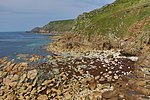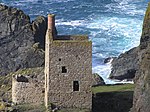Brisons
Celtic SeaLandforms of CornwallPenwithReefs of EnglandReefs of the Atlantic Ocean ... and 3 more
Seabird coloniesSt Just in PenwithUninhabited islands of Cornwall

The Brisons (Cornish: Enys Vordardh, meaning breaker island) is a twin-peaked islet in the Celtic Sea situated 1 mile (1.6 km) offshore from Cape Cornwall in Cornwall, on the south-western coast of Great Britain.
Excerpt from the Wikipedia article Brisons (License: CC BY-SA 3.0, Authors, Images).Brisons
Geographical coordinates (GPS) Address Website Nearby Places Show on map
Geographical coordinates (GPS)
| Latitude | Longitude |
|---|---|
| N 50.12039 ° | E -5.72229 ° |
Address
Cornwall
England, United Kingdom
Open on Google Maps











